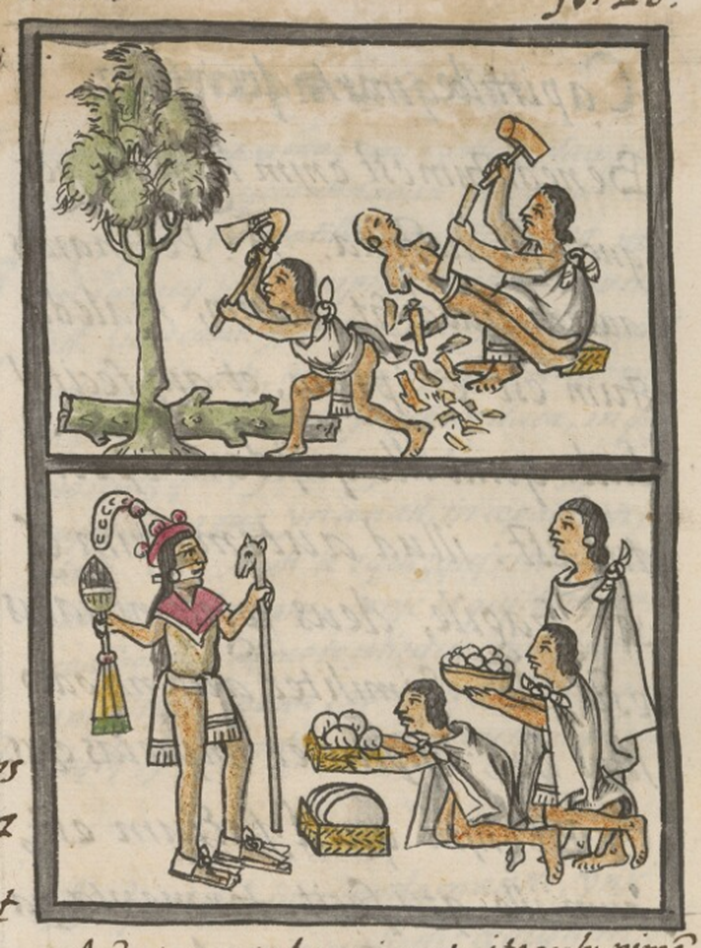Date/Time
Thursday, May 2, 2024
3:00 pm PDT – 4:00 pm PDT
Due to unforeseen circumstances, this talk has been postponed. The new date will be listed here and shared with all registrants soon.
–presented by Chase Caldwell Smith, Doctoral Student, University of California, Los Angeles
Hosted by the Early Modern Research Group
Online event via Zoom
To register for this event, please fill out the form below.
The Florentine Codex is best known as a rich sixteenth-century repository of information – in text and image – of Nahua culture, society, and religion. However, one passage in the manuscript, the appendix to the first book, “The Gods,” offers a distinct perspective, attempting instead to translate the Judeo-Christian concept of “idolatry” into Nahuatl linguistically, conceptually, and visually. This paper examines this case study of “translation,” expanding on the art historian Thomas Cummin’s analysis of the passage. While Cummins focuses primarily on the text’s self-conscious distinction from other parts of the Codex through its visual organization of information, I instead focus on the complexities in the “translation” effort of Bernardino de Sahagún and the indigenous tlacuiloque (painter-scribes) who were central in the production of the manuscript. Drawing inspiration from Kevin Terraciano’s theorization of the “three texts” of the Florentine Codex – which foregrounds the complex interrelationships of the Spanish text, the Nahuatl text, and the images – I examine the ways in which the Latin Vulgate text of the Book of Wisdom is rendered into Nahuatl in an effort to define idolatry. I argue that this text functions as one piece of a larger debate about religious conversion and the translations of idolatry in mid-sixteenth-century New Spain. The choices made in the Nahuatl translation shed light on local ontologies of the sacred and underscore the challenges of establishing commensurability between Christianity and Mesoamerican religions. Furthermore, I argue that this debate revolved around linguistic, conceptual, and visual translations of proper behavior toward numinous, or sacred, matter. Far from being exclusive to central Mexico, this debate unfolded in contexts as diverse as iconoclastic fervor in the Netherlands, the Council of Trent’s reaffirmation of the cult of the saints, missionary observations of the huaca in the Andes, and Inquisitorial trials against “idolatry” in Portuguese Goa. I conclude that this passage is best contextualized not only in the manuscript of which it is an integral part, but in global debates in the Iberian World about the manifestation of the sacred in the physical world.
Chase Caldwell Smith is a fourth-year PhD student at UCLA, where he studies religious conversion and religious change in sixteenth- and seventeenth-century central Mexico through sources including Nahuatl-language doctrinal literature, images, and objects. In addition to a Summer Mentorship from the UCLA Center for 17th- and 18th-Century Studies, his research and language study have been supported by awards including a James R. Scobie Award from the Conference on Latin American History, a Princeton University Library Research Grant, and a FLAS Academic Year Fellowship Award for Nahuatl from the UCLA Latin America Institute. Beyond his studies, he also serves as an officer of the UCLA Medieval & Early Modern Student Association, and has co-organized graduate student conferences on materiality, borders and borderlands, and intersectionality in the early global world.
Image: “Cuauhxinqueh” (wood carvers) and “Tlamana” (to make an offering), Book 1, Folio 26r, The Digital Florentine Codex. https://florentinecodex.getty.edu/book/1/folio/26r/images/f30117d5-3e58-4893-ac4b-b4fed1ce632a


